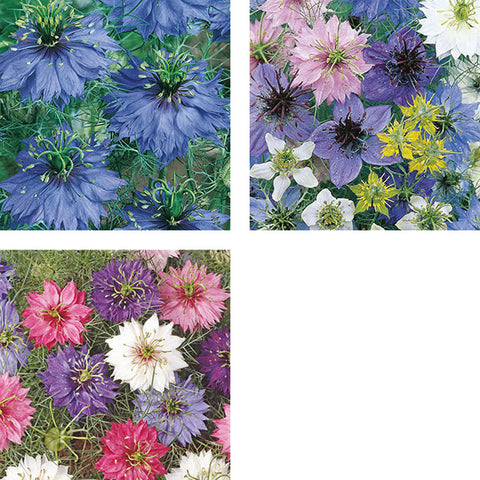Love-in-a-mist is a cherished staple of the cottage garden. Easy to grow, low-maintenance and an ideal gap-filler, these beautiful annuals tick all the boxes for gardeners. Jewel-like flowers appear among masses of feathery foliage, injecting displays with romantic informality when sown in drifts, while blooms make exquisite cut flowers, lasting for seven to 10 days.
Native to north Africa and Mediterranean regions, Nigella – to use its botanical name – is also famed for its decorative seed heads, which form a stylish addition to cut flower arrangements. As long as it’s grown in a sunny part of the garden, love-in-a-mist is fast-growing and wonderfully decorative, while plants will even perform well in poor soils.
For years, Nigella damascena ‘Miss Jekyll’ was the only variety available, and gained legions of fans with masses of beautiful, sky-blue flowers. It remains a firm favourite today, but there are other charming kinds to choose from.
Take Nigella damascena ‘Allsorts’ for example. This brilliant blend works a treat in borders, containers and beds. Ideal for weaving naturally around border plants, blooms are born in shades of white, pink and blue, ramping-up the spectacle and luring beneficial pollinators. ‘Horizon Mix’ is another winner for stunning displays of dainty blooms in a wide assortment of shades.

Clockwise from top-left: Miss Jekyll, Allsorts, Horizon Mix
When to sow
Love-in-a-mist can be sown at any time from March to September. Between April and August, seed can be sown directly into garden soil, but at all other times, you’ll need to sow under cover. Nigella flowers between July and September, with blooms lasting for around eight weeks. For earlier flowers, sow in autumn and grow young plants on in a cold frame.
How to sow
- To start seed into growth under cover, sow into a tray of moist growing media such as Gro-Sure Seed & Cutting Compost.
- Place trays in a propagator in gentle warmth, at a temperature of around 10-15°C.
- To direct sow outdoors, choose a sunny, south or west-facing site with well-drained soil.
- Prepare a seed bed by raking soil to provide a firm, even surface. Raking soil to a fine tilth before sowing creates perfect conditions for seeds to germinate.
- Water the seed bed, then take care to sow thinly, or plants will compete for water, light and nutrients. Sowing in semi-circular lines creates a natural ‘drift’ effect. Cover seeds with a light layer of moist soil.
- Keep the seed bed moist until seedlings appear, then water as necessary if the weather is dry.
Next steps
- When seedlings sown in trays under cover are large enough to handle, carefully prick them out and transplant into trays of multipurpose or potting compost, spacing seedlings 5cm apart.
- Where seed has been direct-sown outdoors, once seedlings are around 3cm tall they should be thinned so they’re spaced around 10cm apart, to prevent overcrowding.
- Love-in-a-mist thrives when plants have room to stretch out, so a further thinning to around 15cm can be beneficial, if needed.
- As long as plants are grown in a sheltered location, they’re fairly low maintenance. However, at more exposed sites, provide support using sticks.
- To maximise plants’ flowering potential, feed regularly using a liquid fertiliser such as Westland Boost.
Deadheading
Deadhead plants regularly to keep more flowers coming. By snipping off faded blooms as soon as they go over, plants will carry on flowering for six to eight weeks. However, attractive seed pods are part of the appeal of love-in-a-mist, so leaving a few spent flowers in situ is preferred by gardeners who are keen to dry seed heads for winter decorations. If you leave a few seed heads on the plant they will self-seed too.
Common problems, pests & diseases
Love-in-a-mist is a reliable, trouble-free plant to grow. Apart from providing a little support in more exposed locations, plants will look after themselves. Poor flowering is often the result of growing in shady locations, as plants need plenty of sunlight to flower freely. Disappointing displays can also result from growing in heavy or waterlogged soils, because free-draining conditions are essential.
Frequently Asked Questions
Why is Nigella often called ‘love-in-a-mist’? The common name sums up the manner in which pastel coloured flowers appear through finely-cut, wispy, feathery foliage.
Is soil improvement necessary? Love-in-a-mist will grow on poor soils, although plants and flowers can be smaller. Working organic matter into soil ahead of planting will result in more dramatic displays of larger flowers on taller plants.
Will plants self-seed? Yes, where seed heads are left in situ, plants will self-seed in the garden – or seed can be collected to sow in autumn.
Back to Learn & Grow

